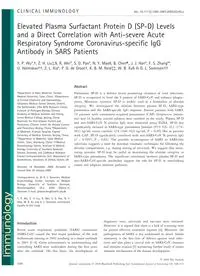
2009 Elevated Plasma Surfactant Protein D (SP-D) Levels and a Direct Correlation with Anti-severe Acute Respiratory Synd PDF
Preview 2009 Elevated Plasma Surfactant Protein D (SP-D) Levels and a Direct Correlation with Anti-severe Acute Respiratory Synd
Elevated Plasma Surfactant Protein D (SP-D) Levels and a Direct Correlation with Anti-severe Acute Respiratory Syndrome Coronavirus-specific IgG Antibody in SARS Patients Y. P. Wu*,�, Z. H. Liu�,§, R. Wei*, S. D. Pan*, N. Y. Mao§, B. Chen–, J. J. Han*, F. S. Zhang**, U. Holmskov��, Z. L. Xia*, P. G. de Groot�, K. B. M. Reid��, W. B. Xu§ & G. L. Sorensen�� Introduction Severe acute respiratory syndrome (SARS) coronavirus (SARS-CoV) caused the first major pandemic of the new millennium starting in 2002 resulting in a major outbreak in 2003 [1–4]. Great achievements in understanding and controlling SARS were undertaken during the first years after the outbreak. On this basis, the development of diagnostic tests, antivirals and vaccines were initiated. However, it is argued that there is a lack of screening tests for proven effective treatment regimes [4]. Moreover, the pathogenesis of SARS is not understood in detail. Innate immunity is the first line of defence against viral infec- tions and also plays a critical role in SARS-CoV clearance and immune evasion [5] warranting further study of innate immune mechanisms of the disease development. *Department of Basic Medicine, Taishan Medical University, Taian, China; �Department of Clinical Chemistry and Haematology, University Medical Center Utrecht, Utrecht, The Netherlands; �The AIDS Research Center, Institute of Pathogen Biology, Chinese Academy of Medical Sciences and Peking Union Medical College, Beijing, China; §Institute for Viral Disease Control and Prevention, Chinese Center for Disease Control and Prevention, Beijing, China; –Department of Medicine, Xuanwu Hospital, Capital University of Medical Sciences, Beijing, China; **Department of Medicine, Taian Medical Center, Taian, Shandong, China; ��Medical Biotechnology Center, Institute of Medical Biology, University of Southern Denmark, Odense, Denmark; and ��Medical Research Council Immunochemistry Unit, Department of Biochemistry, University of Oxford, Oxford, UK Received 18 November 2008; Accepted in revised form 26 January 2009 Correspondence to: Dr G. L. Sorensen, Medical Biotechnology Center, Institute of Medical Biology, University of Southern Denmark, Winsloewparken 25.3, 5000 Odense-C, Denmark. E-mail:
